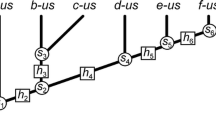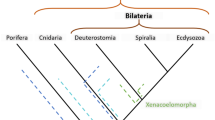Abstract
I respond to the bad lot argument in the context of biological systematics. The response relies on the historical nature of biological systematics and on the availability of pattern explanations. The basic assumption of common descent enables systematic methodology to naturally generate candidate explanatory hypotheses. However, systematists face a related challenge in the issue of character analysis. Character analysis is the central problem for contemporary systematics, yet the general problem of which it is a case—what counts as evidence?—has not been adequately discussed by proponents of inference to the best explanation. Facing this problem is the price of adopting abductive methods. I sketch an account of how systematists approach the problem of evidence.

Similar content being viewed by others
Notes
This formulation captures Peirce’s later writings but would not suffice to distinguish abduction from induction in Peirce’s earlier writings. In his fifth Lowell lecture, Peirce held that both inductive and abductive (hypothetic) inferences enable the reasoner to construct a syllogism which explains the surprising fact of interest. The difference is that inductive reasoning concludes by affirming the rule of the syllogism, whereas abductive reasoning concludes by affirming the case. See for example (Peirce 1982, pp. 427–429).
See Schaffner (1993) for a brief summary, focusing on Hanson’s (1960, 1967) analysis of scientific discovery as largely a matter of abductive (retroductive, in Hanson’s terms) inference. Schaffner argued that Hanson did not clearly distinguish between discovery as the initial generation of hypotheses versus a preliminary evaluation stage. Because Hanson did not offer a logic of generation, in Schaffner’s view Hanson’s abductive inference does not significantly differ from Schaffner’s analysis of the process of discovery along the lines of the hypothetico-deductive method. Scientists appeal to the familiar epistemic virtues that employ explanatory criteria in a preliminary evaluation of which hypotheses are plausible, prior to more formally organized testing in a strong evaluation phase.
Schaffner’s analysis demonstrates that skepticism about the prospects of abductive inference in filling out a logic of discovery does not entail skepticism about the prospects of developing some other logic of discovery. Schaffner presented a preliminary sketch of such a logic (pp. 8–63). The demonstration is salient because some proponents of abductive inference—notably, McMullin (1992)—have argued that only abductive inference enables scientific discovery that is both logically analyzable and genuinely new.
One could ensure that the true explanation is among the set considered by including in the set the hypothesis that all other explanations considered are false (Lipton 2004). Such a hypothesis would have little to no explanatory power with respect to the contrastive question of interest, and inference to this type of explanatory hypothesis is of no use except perhaps as a starting point for further inquiry.
Philosophers have often referred to the methodology of systematics since Hennig (1966) as cladistic. In systematics literature, the term “cladistic” is now associated with a particular subset of methods (parsimony) and practitioners (that eschew maximum likelihood and Bayesian approaches). Hennig’s phrase phylogenetic systematics also sometimes bears this association. The term “phylogenetics” is available to refer in general to contemporary systematic methodology.
This works necessarily for monophyletic taxa: it does not necessarily work at species level and below, nor for groups in which reticulate inheritance is common (such as bacteria and archaea). For a basic three-taxon statement such as I am describing, biological entities can be treated as if they were monophyletic taxa. Over time, in most cases, eukaryote species will satisfy the logical requirements for three-taxon statements to obtain: each member of the species is more closely related to the other members of the species than to any non-conspecific organism. See Haber (2012) for discussion of cases in which the degree of genetic relatedness can come apart from ancestral relatedness considered at the level of the individual organism.
There is also a null hypothesis, that the observations do not represent characters of separate, biologically real entities. The other hypotheses assume that the observed characters, whose distribution is to be explained, are characters of individual, biologically meaningful entities. The assumption is false in the case of an artifact, such as the “type specimen” of Piltdown Man (an artificial association of a doctored human skull and orangutan jaw).
The null hypothesis is also salient when dealing with fragmentary remains which might be assigned to individual organisms. For example, in dealing with a fossil left foot and a fossil right foot, found separately but proximately, paleontologists may attempt to determine whether the remains belonged to the same individual. If so, characters observed from the distinct fossil specimens would be united in a systematic analysis. Alternately, paleontologists might perform separate analyses on the basis of the individual parts—e.g., hypothesize cladograms on the basis of all left foot specimens, ignoring the right feet.
The determination of what counts as an individual organism can be problematic in some taxa, for example with many fungi.
Hennig (1966) identified the ultimate unit of systematic analysis as the semaphorant (an individual organism during a restricted time span, “however brief”—p. 6), but restricted phylogenetic systematics to analysis of phylogenetic relationships that result in patterns of ancestry. Observations taken of the same individual are united so that the individual organism over its lifespan is treated as a single entity in phylogenetic analysis.
Development of such strategies has been a critical research area in recent phylogenetics. Solving the philosophical problem just is a scientific challenge, and phylogeneticists have good reasons to think that contemporary tree-building strategies provide a good solution.
Sober’s concern was to analyze whether and why systematists should take apomorphic characters to be more informative than plesiomorphic characters. In most situations, apomorphic characters are more informative than plesiomorphic characters, but Sober argued that it is the expected rareness of the shared characters rather than their status as derived (apomorphic) versus ancestral (plesiomorphic) that makes the evidentiary difference.
Adanson did not in fact rely on the calculational method that Sneath (1964) ascribed to him, but rather appealed to comparative methods after already having proposed natural groupings of his specimens. Adanson thus did not exemplify a purely numerical, theory-free approach. The historiographic error about Adanson’s methodology appears to trace back through Candolle to Cuvier.
The example summarizes Candolle’s approach to classifying the Crucifères, a group that corresponds to the family now called Brassicaceae; this includes mustard, cabbage, water cress, and 338 total genera (Al-Shehbaz et al. 2006).
Candolle’s terms “primitive state” and “originally” are not to be understood here as evolutionary. The terms are compatible with evolutionary reasoning but would also fit with other theories about organic form. Candolle used the terms methodologically, in the sense described by Naef (1972) [1921], pp. 14–15.
Here I (like Whewell—e.g., 1857c, p. 365) use “aborted” for avorté; note that avortement does not always involve the complete loss of parts. Candolle’s definition: “Avortement (Abortus), état dans lequel un organe n’a pas pris l’accroissement qui lui est ordinaire, sans qu’on puisse toujours y reconnaître une cause immédiate” (de Candolle 1813, p. 406).
Candolle required background knowledge about physical possibility and developmental resources, but he did not require knowledge that these possibilities and resources are partly the result of evolutionary processes. Knowledge about evolution may help, however, and is necessary to justify the assumptions systematists now make when using phylogenetic methodology. These assumptions are required to generate the set of patterns of relationship as possible explanations.
References
Adanson, M. (1763). Familles des plantes par M. Adanson. Paris: chez Vincent.
Al-Shehbaz, I. A., Beilstein, M. A., & Kellogg, E. A. (2006). Systematics and phylogeny of the Brassicaceae (Cruciferae): An overview. Plant Systematics and Evolution, 259(2), 89–120.
Cleland, C. E. (2002). Methodological and epistemic differences between historical science and experimental science*. Philosophy of Science, 69(3), 447–451.
Cleland, C. E. (2011). Prediction and explanation in historical natural science. The British Journal for the Philosophy of Science, 62(3), 551–582.
de Candolle, A. P. (1813). Théorie Élémentaire de la Botanique: Ou, Exposition des Principes de la Classification Naturelle et de l’Art de Décrire et d’Étudier les Végétaux. Paris: Deterville.
Eldredge, N. (1979). Cladism and common sense. In J. Cracraft & N. Eldredge (Eds.), Phylogenetic analysis and paleontology (pp. 165–198). New York: Columbia University Press.
Frankfurt, H. G. (1958). Peirce’s notion of abduction. The Journal of Philosophy, 55, 593–597.
Goudge, T. A. (1961). The ascent of life: A philosophical study of the theory of evolution. London: G. Allen and Unwin.
Haber, M. H. (2012). Multilevel lineages and multidimensional trees: The levels of lineage and phylogeny reconstruction. Philosophy of Science, 79(5), 609–623.
Hanson, N. R. (1960). Is there a logic of scientific discovery? Australasian Journal of Philosophy, 38(2), 91–106.
Hanson, N. R. (1967). An anatomy of discovery. The Journal of Philosophy, 64, 321–352.
Hennig, W. (1966). Phylogenetic systematics (D. D. Davis, & R. Zangerl, Trans.). Urbana, IL: University of Illinois Press.
Lipton, P. (2004). Inference to the best explanation. London: Routledge.
Mayr, E. (1982). The growth of biological thought: Diversity, evolution, and inheritance. Cambridge, MA: Belknap Press.
McMullin, E. (1992). The inference that makes science. Milwaukee, WI: Marquette University Press.
Naef, A. (1972). Cephalopoda (A. Mercado, Trans., Vol. 1, Fauna and flora of the Bay of Naples). Jerusalem [Berlin]: Israel Program for Scientific Translation [Verlag von R. Friedländer and Sohn].
O’Hara, R. J. (1988). Homage to Clio, or, toward an historical philosophy for evolutionary biology. Systematic Biology, 37(2), 142–155.
Peirce, C. S. (1934). Pragmatism and Pragmaticism. In C. Hartshorne & P. Weiss (Eds.), The collected papers of Charles Sanders Peirce. Electronic edition. (Vol. 5). Cambridge, MA: Harvard University Press.
Peirce, C. S. (1982). Writings of Charles S. Peirce: A chronological edition (Vol. 1, pp. 1857–1866). Bloomington, IN: Indiana University Press.
Richards, R. (2003). Character individuation in phylogenetic inference. Philosophy of Science, 70(2), 264–279.
Rieppel, O., & Kearney, M. (2006). The poverty of taxonomic characters. Biology and Philosophy, 22(1), 95–113.
Schaffner, K. F. (1993). Discovery and explanation in biology and medicine. Chicago: University of Chicago Press.
Sneath, P. H. A. (1964). Mathematics and classification from Adanson to the present. In G. H. Lawrence (Ed.), Adanson: The bicentennial of Michel Adanson’s “Familles des plantes” (Vol. 1, pp. 471–498). Pittsburgh, PA: Hunt Institute for Botanical Documentation.
Sober, E. (1991). Reconstructing the past: Parsimony, evolution, and inference. Cambridge, MA: MIT Press.
Sober, E. (2008). Evidence and evolution: The logic behind the science. Cambridge, MA: Cambridge University Press.
Sokal, R. P., & Sneath, P. H. A. (1963). Principles of numerical taxonomy. San Francisco: W. H. Freeman.
Turner, D. (2007). Making prehistory: Historical science and the scientific realism debate. Cambridge, MA: Cambridge University Press.
Van Fraassen, B. C. (1989). Laws and symmetry. Oxford: Clarendon Press.
Wheeler, Q. D. (2007). Invertebrate systematics or spineless taxonomy? Zootaxa, 1668, 11–18.
Whewell, W. (1840). The philosophy of the inductive sciences: Founded upon their history (Vol. 2). London: John W. Parker.
Winther, R. G. (2009). Character analysis in cladistics: Abstraction, reification, and the search for objectivity. Acta Biotheoretica, 57(1–2), 129–162.
Acknowledgments
I thank James Lennox, Kevin de Queiroz, and two anonymous reviewers for comments that improved this paper. Parts of this work were supported by a Smithsonian Institution Predoctoral Fellowship and by a Grant from the University of Pittsburgh’s Provost Development Fund.
Author information
Authors and Affiliations
Corresponding author
Rights and permissions
About this article
Cite this article
Quinn, A. Phylogenetic inference to the best explanation and the bad lot argument. Synthese 193, 3025–3039 (2016). https://doi.org/10.1007/s11229-015-0908-9
Received:
Accepted:
Published:
Issue Date:
DOI: https://doi.org/10.1007/s11229-015-0908-9




